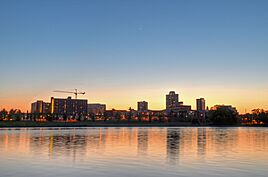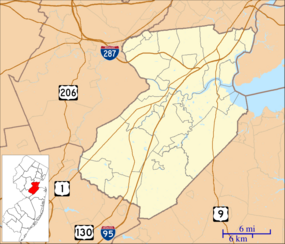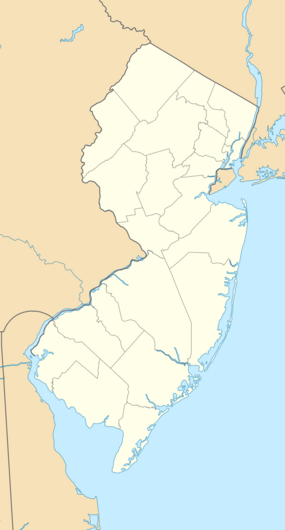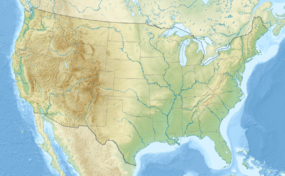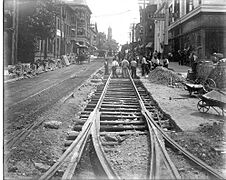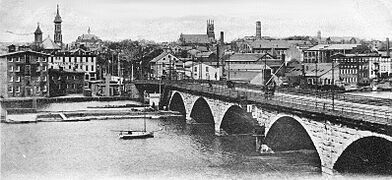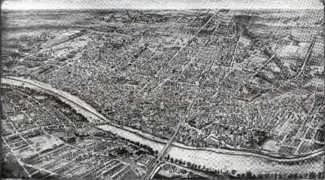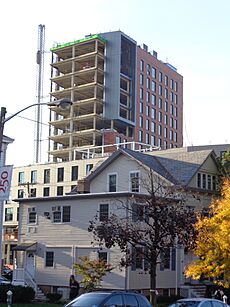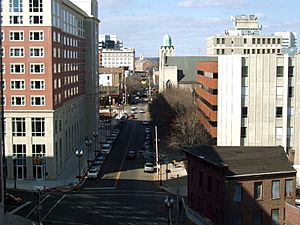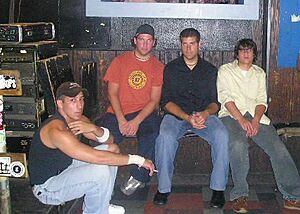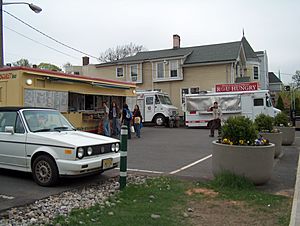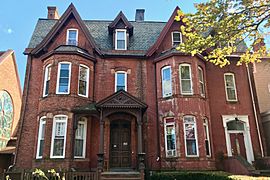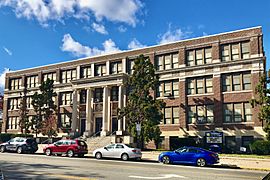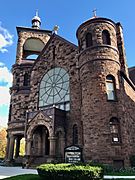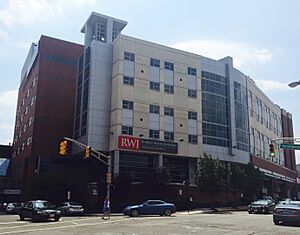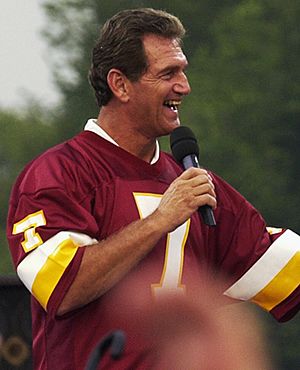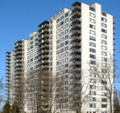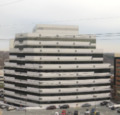New Brunswick, New Jersey facts for kids
New Brunswick is a city in Middlesex County, New Jersey. It's known as the "Hub City" and "Healthcare City" because it's a busy center for business and home to many hospitals and medical schools. New Brunswick is also a college town, home to Rutgers University–New Brunswick, which is New Jersey's largest university. Many people who live here also travel to New York City for work.
The city is located on the Raritan River, about 27 miles (43 km) southwest of Manhattan. In 2020, about 55,266 people lived in New Brunswick. The city is a major center for science, arts, and culture, and its downtown area is growing with new tall buildings. New Brunswick is also famous for its many different cultures, with large Hungarian, Asian, and Hispanic communities.
Quick facts for kids
New Brunswick, New Jersey
|
||
|---|---|---|
|
City
|
||
|
Skyline of New Brunswick
Rutgers University–New Brunswick
George Street Playhouse
|
||
|
||
| Nickname(s):
Hub City, Healthcare City
|
||
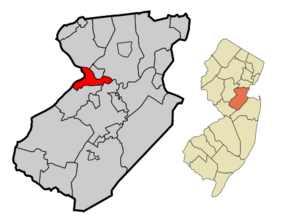
Location of New Brunswick in Middlesex County highlighted in red (left). Inset map: Location of Middlesex County in New Jersey highlighted in orange (right).
<mapframe text="Interactive map of New Brunswick, New Jersey" zoom="11" width="285" height="250"> { "type": "ExternalData", "service": "geoshape", "ids": "Q138338" } </mapframe> |
||
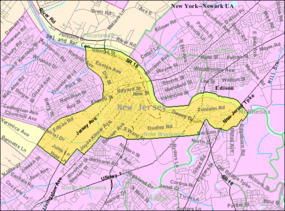
Census Bureau map of New Brunswick, New Jersey
|
||
| Country | ||
| State | ||
| County | Middlesex | |
| Established | December 30, 1730 | |
| Incorporated | September 1, 1784 | |
| Named for | Braunschweig, Germany, or King George II of Great Britain | |
| Government | ||
| • Type | Faulkner Act (mayor–council) | |
| • Body | City Council | |
| Area | ||
| • Total | 5.75 sq mi (14.90 km2) | |
| • Land | 5.23 sq mi (13.55 km2) | |
| • Water | 0.52 sq mi (1.35 km2) 9.06% | |
| Area rank | 264th of 565 in state 14th of 25 in county |
|
| Elevation | 62 ft (19 m) | |
| Population
(2020)
|
||
| • Total | 55,266 | |
| • Estimate
(2023)
|
55,846 | |
| • Rank | 32nd of 565 in state 6th of 25 in county |
|
| • Density | 10,561.1/sq mi (4,077.7/km2) | |
| • Density rank | 719th in country (as of 2023) 37th of 565 in state 2nd of 25 in county |
|
| Time zone | UTC−05:00 (Eastern (EST)) | |
| • Summer (DST) | UTC−04:00 (Eastern (EDT)) | |
| ZIP Codes |
08901–08906, 08933, 08989
|
|
| Area code(s) | 732/848 and 908 | |
| FIPS code | 3402351210 | |
| GNIS feature ID | 0885318 | |
| New Brunswick is the county seat for Middlesex County. | ||
Contents
- History of New Brunswick
- Geography of New Brunswick
- Economy and Healthcare in New Brunswick
- Arts and Culture in New Brunswick
- Education in New Brunswick
- Historic Places to Visit
- Transportation in New Brunswick
- Healthcare Facilities
- Notable People from New Brunswick
- Sister Cities
- Images for kids
- See also
History of New Brunswick
How New Brunswick Got Its Name
The area where New Brunswick is today was first home to the Lenape Native Americans. The first European settlement here was in 1681. It was first called Prigmore's Swamp, then Inian's Ferry. In 1714, the settlement was named New Brunswick. This name came from the city of Braunschweig (which is "Brunswick" in German) in Germany. It might also have been named after King George II of Great Britain.
Early Days: Colonial Times and the American Revolution
New Brunswick was a key spot for travelers and traders during colonial times. It was located between New York City and Philadelphia on an important road called the King's Highway. The city also sat along the Raritan River. New Brunswick officially became a town in 1736 and a city in 1784.
During the American Revolutionary War, British soldiers took over the city in the winter of 1776–1777. On July 9, 1776, the Declaration of Independence was read publicly in New Brunswick by Colonel John Neilson. A statue now marks this important event.
Rutgers University: A Historic College in New Brunswick
Rutgers University, first called Queen's College, was founded in 1766. In 1771, the college decided to make New Brunswick its home. Classes started in a tavern, and the first student graduated in 1774. The oldest building on the Rutgers campus, Old Queens, was finished in 1811. Today, Rutgers is the state university of New Jersey.
The New Brunswick Theological Seminary, a religious school, moved to New Brunswick in 1810. It shared space with Queen's College for a while.
-
Old Queens, the oldest building at Rutgers University
African American Community in New Brunswick
The African American community in New Brunswick has a long history, dating back to the 1700s. In the early 1800s, some free African Americans lived in a part of the city called Halfpenny Town. This area was a place where free Black people could gather and socialize.
In the early 1800s, Black and White residents often shared places of worship. However, in 1817, the African Association of New Brunswick was formed. This group helped create a space for Black residents to meet and discuss important topics like religion and freedom. The African Association also started the African School in 1822, which welcomed both free and enslaved Black students.
By 1827, free and enslaved Black people in New Brunswick established the Mount Zion African Methodist Episcopal Church. This was the first African American church in Middlesex County. It is still active today.
In 1828, about 11% of New Brunswick's population was African American, including both free and enslaved people. The city was also a stop on the Underground Railroad, helping many enslaved people find their way to freedom.
Hungarian Community in New Brunswick
New Brunswick has been called the nation's "most Hungarian city." Hungarian immigrants started arriving in 1888, often to work at Johnson & Johnson factories. They mostly settled in the area known as the Fifth Ward.
Even though many new immigrants have moved to New Brunswick since then, the Hungarian community is still active. There's an annual Hungarian Festival held every June. Many Hungarian churches and organizations continue to thrive in the city. You can also find landmarks named after Hungarian figures, like Lajos Kossuth Street and a memorial to the 1956 Hungarian Revolution.
Latino Community in New Brunswick
Since the 1960s, many new residents in New Brunswick have come from Latin American countries. In 2010, about half of the city's population identified as Hispanic. Many people moved from Puerto Rico in the 1970s, and later from the Dominican Republic, Guatemala, Honduras, Ecuador, and Mexico.
Modern Development and Tall Buildings
New Brunswick has seen a lot of new development, especially in its downtown area. In the 1960s and 70s, some parts of the city became run-down. To help fix this, Rutgers University, Johnson & Johnson, and the city government teamed up to create the New Brunswick Development Company (DevCo) in 1975. Their goal was to bring new life to the city center.
Johnson & Johnson decided to keep its world headquarters in New Brunswick and built a new building in 1983. This led to more new buildings and projects in the city. Today, New Brunswick's skyline is growing with many modern high-rise buildings.
Tallest Buildings in New Brunswick
New Brunswick has many tall buildings, especially those built in the 21st century. Here are some of the tallest:
| Rank | Name | image | Height ft/m |
Floors | Year | Notes |
|---|---|---|---|---|---|---|
| 1 | The Gateway | 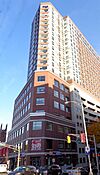 |
298 ft (91 m) | 24 | 2012 | |
| 2 | New Brunswick Performing Arts Center | 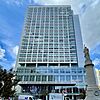 |
282 ft (86 m) | 22 | 2019 | |
| 3 | One Spring Street | 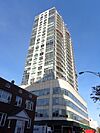 |
258 ft (79 m) | 23 | 2006 | |
| 4 | One Johnson and Johnson Plaza | 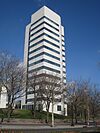 |
228 ft (69 m) | 16 | 1983 | Headquarters of Johnson & Johnson |
| 5 | The Standard at New Brunswick | 225 ft (69 m) | 21 | 2020 | ||
| 6 | Colony House |  |
246 ft (75 m) | 20 | 1962 | |
| 7 | Skyline Tower |  |
194 ft (59 m) | 14 | 1967/2003 | |
| 8 | Schatzman-Fricano Apartments | 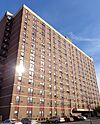 |
194 ft (59 m) | 14 | 1963 | |
| 9 | The George | 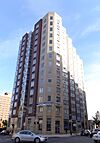 |
14 | 2013 | ||
| 10 | Riverside Towers | 177 ft (54 m) | 13 | 1964 | ||
| 11 | The Heldrich | 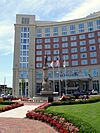 |
160 ft (50 m) | 11 | 2007 | |
| 12 | Rockhoff Hall/SoCam290 | 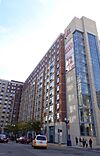 |
160 ft (50 m) | 12 | 2005 | |
| 13 | Aspire | 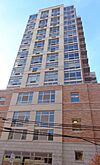 |
161 ft (49 m) | 16/17 | 2015 | |
| 14 | The Yard |  |
161 ft (49 m) | 14 | 2016 | |
| 15 | 410 George Street |  |
154 ft (47 m) | 11 | 1989 | |
| 16 | University Center | 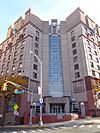 |
149 ft (45.3 m) | 12 | 1994 |
Geography of New Brunswick
New Brunswick covers about 5.75 square miles (14.90 km²). Most of this is land, with a small part being water. The city is located on the south side of the Raritan Valley.
New Brunswick is surrounded by other towns like Piscataway, Highland Park, and Edison. It also borders North Brunswick and East Brunswick.
New Brunswick's Climate
New Brunswick has warm, humid summers and cool winters. It gets a fair amount of rain throughout the year. The average snowfall in winter is about 29 inches (74 cm).
Economy and Healthcare in New Brunswick
Healthcare Industry
New Brunswick is often called "The Health Care City" because the healthcare industry is very important here. It's home to the world headquarters of Johnson & Johnson. There are also several major medical teaching and research centers, including Robert Wood Johnson University Hospital and Robert Wood Johnson Medical School.
Urban Enterprise Zone
Parts of New Brunswick are in an Urban Enterprise Zone. This means that shoppers can pay a lower sales tax (3.3125%) at certain stores, which helps encourage business and jobs in the area.
Arts and Culture in New Brunswick
Theatre and Performing Arts
The New Brunswick Performing Arts Center opened in 2019. The city is also home to three professional theaters: Crossroads Theatre, George Street Playhouse, and the State Theatre. Crossroads Theatre even won a special Tony Award! Rutgers University also has student theater groups.
Journalism
New Brunswick Today is a local newspaper and online news source that covers community issues. Other local publications like The Aquarian Weekly and NJ Indy focus on music and arts.
Museums and Art
You can visit the Zimmerli Art Museum at Rutgers University and the Rutgers University Geology Museum in New Brunswick. The city was also an important place for modern art in the 1950s–1970s, with many famous artists teaching at Rutgers.
Music Scene
New Brunswick has a lively music scene, especially for punk rock and indie rock. Many bands that became famous, like The Smithereens and Bon Jovi, started here. Local clubs like the Court Tavern and the Melody Bar have hosted many bands. The city also has jazz festivals and local rappers.
Film Festivals
New Brunswick hosts several film festivals, including the New Jersey Film Festival and the United States Super 8mm Film + Digital Video Festival.
Grease Trucks
The "Grease trucks" were famous food trucks on the College Avenue Campus at Rutgers. They were known for their "Fat Sandwiches," which are sub rolls filled with fried foods. In 2013, the trucks moved to different spots on campus due to new construction.
Education in New Brunswick
Public Schools
The New Brunswick Public Schools serve students from pre-kindergarten through high school. The district has 12 schools, including:
- Lincoln Elementary School
- Livingston Elementary School
- Lord Stirling Elementary School
- McKinley Community Elementary School
- A. Chester Redshaw Elementary School
- Paul Robeson Community School For The Arts
- Roosevelt Elementary School
- Blanquita B. Valenti Community School
- Woodrow Wilson Elementary School
- New Brunswick Middle School
- New Brunswick High School
Students from Middlesex County can also apply to special high school programs at the Middlesex County Vocational and Technical Schools.
Colleges and Universities
- Rutgers University has three campuses in New Brunswick: College Avenue, Douglass, and Cook.
- The New Brunswick Theological Seminary, a religious school, is also located here.
- Robert Wood Johnson Medical School, part of Rutgers University, is in New Brunswick.
- Middlesex County College has some facilities downtown.
Historic Places to Visit
The Livingston Avenue Historic District is a historic area with many interesting buildings from the late 1800s and early 1900s.
Here are some other interesting places in New Brunswick:
- The Albany Street Bridge: A stone bridge built in 1892 that was part of the historic Lincoln Highway.
- Old Queens Campus at Rutgers University: The oldest building at Rutgers, built in 1809.
- Buccleuch Mansion: A historic house built in 1739, now part of Buccleuch Park.
- The Henry Guest House: A Georgian stone farmhouse built in 1760.
- William H. Johnson House: An example of Italianate architecture from the 1870s.
- St. Peter the Apostle Church: A church built in 1856.
- Delaware and Raritan Canal: A canal completed in 1834 that was used to transport goods.
- Birthplace of poet Joyce Kilmer: The house where the famous poet was born.
- Site of Johnson & Johnson world headquarters.
- Willow Grove Cemetery: A historic cemetery.
- Mary Ellis grave: A unique grave located in a parking lot.
- Elmer B. Boyd Park: A park along the Raritan River.
Transportation in New Brunswick
New Brunswick has many roads and highways, including U.S. Route 1 and Route 18. The New Jersey Turnpike (Interstate 95) is also nearby.
Public Transportation
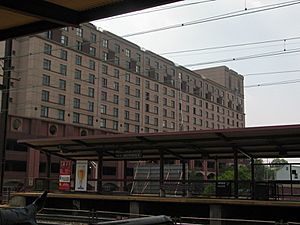
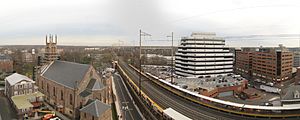
New Brunswick is served by NJ Transit and Amtrak trains on the Northeast Corridor Line. You can take trains north to New York City or south to Trenton.
Local bus service is provided by NJ Transit, and there's also a large Rutgers Campus bus network. Other bus services connect New Brunswick to nearby towns and even New York City and Washington, D.C..
Healthcare Facilities
New Brunswick is home to several major hospitals and medical centers, which is why it's called the "Healthcare City." These include:
- Saint Peter's University Hospital
- Robert Wood Johnson University Hospital
- Robert Wood Johnson Medical School
- The Cancer Institute of New Jersey
- The Bristol-Myers Squibb Children's Hospital
Notable People from New Brunswick
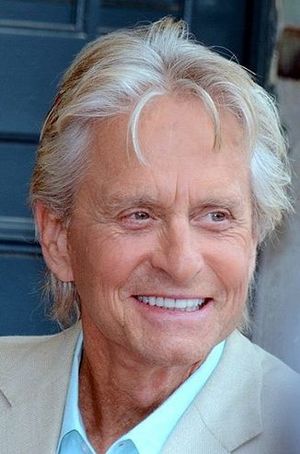
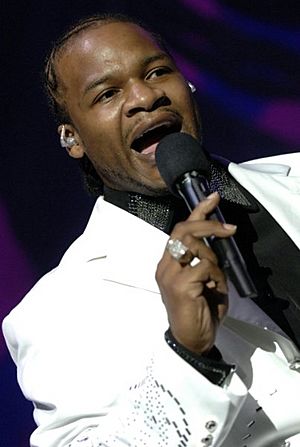
Many interesting people have connections to New Brunswick, including:
- Michael Douglas (born 1944), a famous actor.
- Laurie Hernandez (born 2000), an Olympic gymnast.
- Jaheim (born 1978), an R&B singer.
- Joe Theismann (born 1949), a former professional football player.
- Joyce Kilmer (1886–1918), a well-known poet.
- Floyd Mayweather Jr. (born 1977), a champion boxer who grew up in the city.
- Sydney McLaughlin-Levrone (born 1999), a world record-holding hurdler and sprinter.
- Robert Wood Johnson I (1845–1910), one of the founders of Johnson & Johnson.
- Woody Johnson (born 1947), a businessman and diplomat.
Sister Cities
New Brunswick has "sister city" relationships with other cities around the world. These connections help promote cultural exchange and understanding. New Brunswick's sister cities are:
 Debrecen, Hungary
Debrecen, Hungary Fukui, Japan
Fukui, Japan County Limerick, Ireland
County Limerick, Ireland Tsuruoka, Japan
Tsuruoka, Japan
Images for kids
-
Old Queens, the oldest building at Rutgers University
-
The Committee of Hungarian Churches and Organizations of New Brunswick commemorating the anniversary of the Hungarian Revolution of 1956
-
Southbound platform of New Brunswick's NJ Transit train station
-
Panorama of New Brunswick station track to New York City
-
Actor Michael Douglas
-
Gymnast Laurie Hernandez at the 2016 Summer Olympics
-
R&B singer Jaheim
See also
 In Spanish: Nuevo Brunswick (Nueva Jersey) para niños
In Spanish: Nuevo Brunswick (Nueva Jersey) para niños


